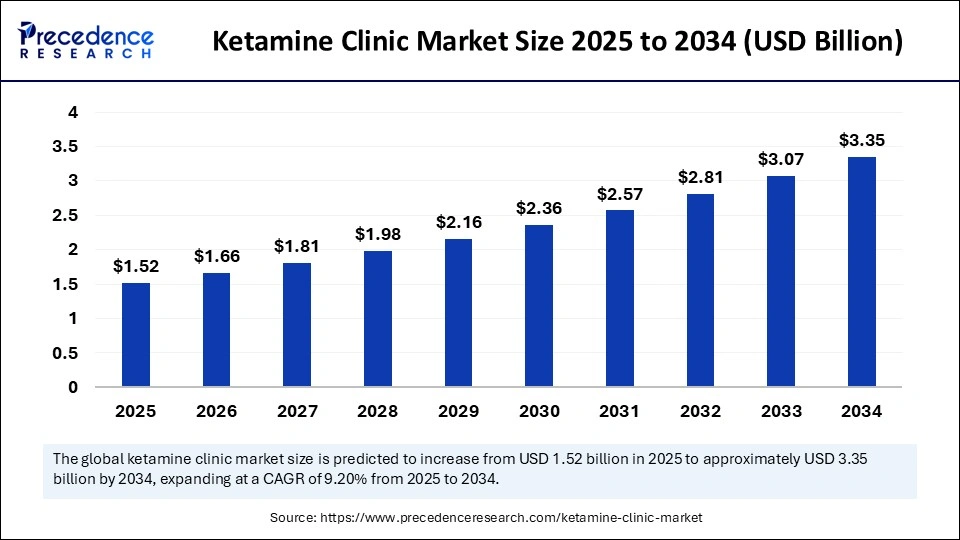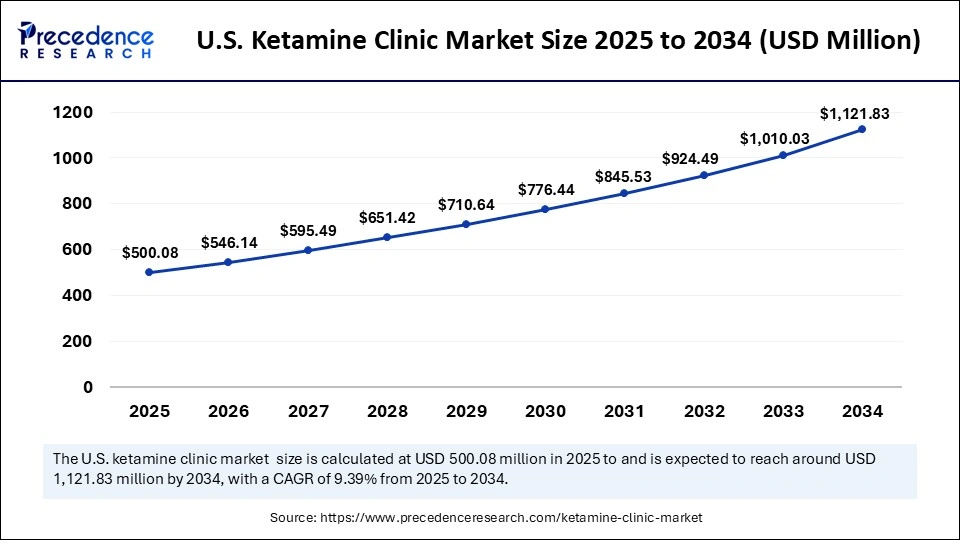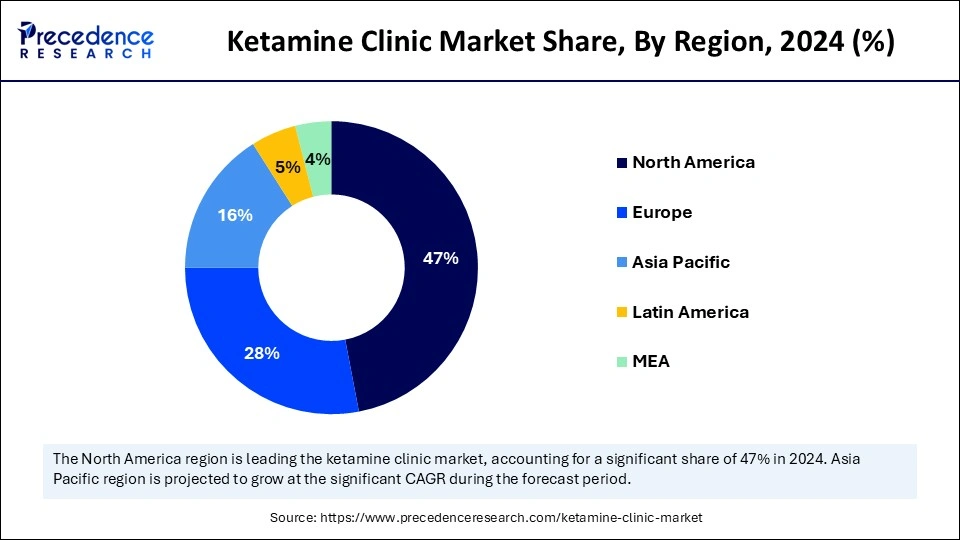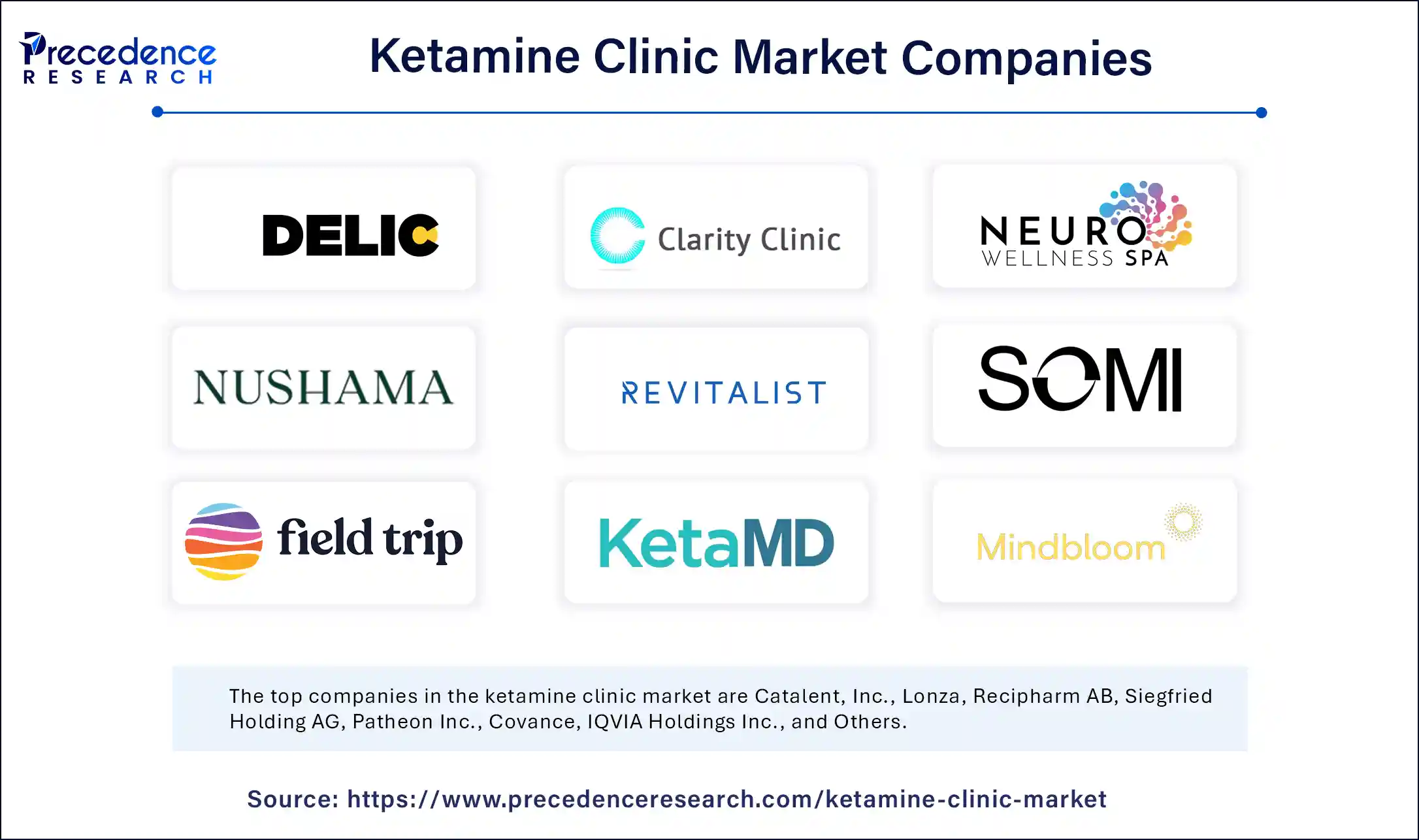List of Contents
Ketamine Clinic Market Size and Forecast 2025 to 2034
The global ketamine clinic market size accounted for USD 1.39 billion in 2024 and is predicted to increase from USD 1.52 billion in 2025 to approximately USD 3.35 billion by 2034, expanding at a CAGR of 9.20% from 2025 to 2034. With the increasing popularity and greater acceptance among physicians, the adoption of ketamine is expanding quickly to help those with mental health issues.

Ketamine Clinic Market Key Takeaways
- In terms of revenue, the ketamine clinic market is valued at 1.52 billion in 2025.
- It is projected to reach 3.35 billion by 2034.
- The market is expected to grow at a CAGR of 9.20% from 2025 to 2034.
- North America dominated the global market with the largest market share of 47% in 2024.
- By region, Asia Pacific is expected to register the fastest CAGR between 2025 and 2024.
- By treatment type, the depression segment captured the biggest market share in 2024.
- By treatment type, the anxiety disorders segment is expected to grow at a significant CAGR over the forecast period.
- By route of administration, the intravenous segment contributed the highest market share in 2024.
- By route of administration, the oral segment is expected to expand to the fastest CAGR during the forecast period.
- By patient demographics, the adults segment has held the largest market share in 2024.
- By patient demographics, the geriatric segment is expected to grow at a rapid pace in the coming years.
How is AI Transforming the Ketamine Clinic Market?
Artificial intelligence AI in Ketamine clinics helps doctors evaluate patients quickly and give each person individual treatment. AI, chatbots, and virtual assistants allow people to get quick answers to their questions and schedule appointment reminders. Using Use of AI for scheduling, billing, and keeping records reduces the workload on staff. AI significantly reduces expenses related to treatments. More ketamine clinics are adopting AI solutions to offer patients more accurate and personalized treatments.
U.S. Ketamine Clinic Market Size and Growth 2025 to 2034
The U.S. ketamine clinic market size was exhibited at USD 457.31 million in 2024 and is projected to be worth around USD 1,121.83 million by 2034, growing at a CAGR of 9.39% from 2025 to 2034.

Why did North America Dominate the Ketamine Clinic Market in 2024?
North America registered dominance in the market by holding the maximum share in 2024. This is mainly due to the increased awareness among people and healthcare providers about the potential of ketamine therapies. The region has advanced health centers, facilitating the rapid adoption of ketamine therapies. Governments around the region are making initiatives to spread awareness about mental illnesses. There is a high demand for innovative treatment options, opening up avenues for ketamine therapies. In addition, the increased number of cases of mental health issues like depression, anxiety, and PTSD contributed to the region’s dominance. The U.S. is a major market in the region, driven by increased availability and high adoption of innovative therapies like ketamine.

Why is Asia Pacific Experiencing the Fastest Growth in the Ketamine Clinic Market?
Asia Pacific is expected to grow at the fastest CAGR during the forecast period. The rising awareness among people about mental health issues and increasing healthcare spending are driving the growth of the market in the region. There is a high demand for innovative therapies, such as ketamine. The increasing prevalence of mental health issues supports market growth. In addition, the growing aging population, especially in countries like China, Japan, and India, is likely to drive regional market growth. Governments around the region are investing heavily in advancing healthcare systems, creating opportunities for ketamine to be included in clinical practices on a large scale.
What Opportunities Exist in the Ketamine Clinic Market Within Europe?
Europe is considered to be a significantly growing area. Studies into ketamine are frequently carried out in European hospitals and research centers. Due to favorable environments, healthcare providers are increasingly preferring ketamine therapies for treating mental health issues. However, using ketamine for mental health is approved in Europe. Several European nations are now including ketamine therapy in practices, which supports the regional market.
Market Overview
Ketamine clinics are quickly changing the mental health sector by providing new treatments for people whose depression, anxiety, PTSD, or chronic pain do not respond well to other therapies. Ketamine differs from old therapies in that it provides fast pain relief, sometimes within hours, which makes it a good choice. There has been a huge increase in people seeking ketamine treatments because mental health disorders are more common, and existing antidepressants tend to have side effects.
Due to increasing clinical studies, progress in regulations, and more funding, ketamine clinics are now valuable and important in today’s mental health services. The ketamine clinic market is witnessing rapid growth due to the increasing number of people suffering from mental health conditions that do not respond to traditional therapies. Because of telehealth, ketamine clinics are now able to give consultations and provide care even when patients are far from the clinic. This makes it easier for people in rural and underserved areas to get mental health care.
Which Key Factors are Boosting the Growth of the Ketamine Clinic Market?
- Greater Number of People Developing Mental Health Issues : The rising occurrence of depression, anxiety, and PTSD creates the need for new methods of treatment. As ketamine works quickly and provides relief when other drugs have failed, ketamine is popular with many patients.
- Rising Investment : One of the positive developments of the rising success of ketamine clinics is that they can attract increased capital and financing from venture capitalists and more financial resources from the healthcare system. These changes offer increased opportunities for clinics to employ new methods, participate in research, and bring on new treatments and innovations in the field of mental health treatment.
- Efficacy in Treatment-Resistant Cases : People are attracted to ketamine clinics whose depression or PTSD doesn’t respond to other treatments. The increase in success stories leads to a greater need for ketamine, so more clinics open, and more doctors begin to offer it in their practices.
Market Scope
| Report Coverage | Details |
| Market Size by 2034 | USD 3.35 Billion |
| Market Size in 2025 | USD 1.52 Billion |
| Market Size in 2024 | USD 1.39 Billion |
| Market Growth Rate from 2025 to 2034 | CAGR of 9.20% |
| Dominating Region | North America |
| Fastest Growing Region | Asia Pacific |
| Base Year | 2024 |
| Forecast Period | 2025 to 2034 |
| Segments Covered | Treatment Type, Route of Administration, Patient Demographics and Region |
| Regions Covered | North America, Europe, Asia-Pacific, Latin America, and Middle East & Africa |
Market Dynamics
Drivers
Growing Prevalence of Mental Health Disorders
The number of people dealing with depression, anxiety, PTSD, and bipolar disorder is growing rapidly, which is a key factor driving the growth of the ketamine clinic market. According to the World Health Organization (WHO), depression is one of the major causes of disability. Coinciding with the COVID-19 pandemic, mental health issues have increased among teenagers and young adults, especially depression and anxiety. Ketamine is being seen as a good alternative, especially for cases of depression that don’t improve with standard antidepressants. Since it works quickly to lessen symptoms, ketamine is considered a main treatment for the global mental health challenge. Because of this trend, there are more specialized clinics to handle the growing number of patients seeking fast and effective solutions in mental health care.
The World Health Organization (WHO) estimated that around 280 million people globally suffer from depression, with nearly 700,000 dying by suicide annually. (Source: https://www.knowledge-action-portal.com)
Restraint
High Treatment Costs
Expensive treatments are limiting the development of the ketamine clinic market worldwide. Many patients worldwide find it difficult to keep up with multiple treatments, which can be quite costly. Many countries do not include ketamine treatments for mental health in their national health insurance because they consider them to be not fully approved or experimental. Because they are not reimbursed, many patients need to pay for themselves, so these treatments are out of reach for a large number of people in many countries. Since ketamine-based treatments are not widely accessible, the world's mental health system is not able to expand ketamine treatment globally.
Opportunity
Expansion into Developing Markets
As ketamine clinics are opened in different markets, it creates a huge opportunity for ketamine therapy to become more popular internationally. Because of changes in life and occupational environments in many Latin American and Asian communities, people are experiencing more depression, anxiety, and PTSD. More people learning about alternatives to standard care makes ketamine a standout, mainly for cases that don’t respond to other treatments. The lack of mental health care options, growing public awareness, and government actions are helping ketamine clinics gain a position in those regions.
Treatment Type Insights
Why is Depression the Dominant Treatment Segment in the Ketamine Clinic Market?
The depression segment dominated the market with the largest revenue share in 2024. The main reason behind the segment’s dominance is the increased number of people suffering from major depressive disorder (MDD) and treatment-resistant depression (TRD). More medical professionals are realizing ketamine’s benefits for depression, which has encouraged the creation of many clinics dedicated to treating depression. Many people are visiting these clinics because they want quick and effective answers for major depressive episodes. A deeper understanding of mental health, new clinical studies, and a rising number of mental health resources have all encouraged progress in this market.
The anxiety disorders segment is expected to grow at a significant CAGR over the forecast period. The growth of the segment is attributed to the increasing prevalence of anxiety disorders like generalized anxiety disorder (GAD), panic disorder, and social anxiety disorder among adults as well as children. Since traditional anxiety treatments may take a long time to work and may not always be very effective, many people are looking for new options. Ketamine has proven effective in reducing anxiety symptoms, making it suitable for patients’ resistance to psychotherapy or standard drugs. People and healthcare providers alike have become aware of ketamine’s positive impact, driving its adoption in the treatment for anxiety.
Route of Administration Insights
Why did the Intravenous Segment Dominate the Ketamine Clinic Market in 2024?
The intravenous segment dominated the market by capturing the largest share in 2024. Many healthcare providers prefer IV ketamine because it quickly alleviates symptoms. Consequently, it is very helpful in treating extreme depression, PTSD, and long-term pain, where quick improvements matter the most. Many clinics are selecting IV treatment because it provides precise doses of ketamine, enhancing patient outcomes. Most IV treatments are performed at outpatient clinics with infusions tailored to the unique needs of each patient. IV administration is widely preferred for its rapid onset of action, making it suitable for delivering ketamine in severe cases.
The oral segment is expected to expand at the fastest CAGR during the forecast period. Some patients prefer to receive therapy at home or in outpatient settings, boosting the demand for oral ketamine. As oral ketamine will be slower and less well-absorbed compared to IV ketamine, it is an appropriate treatment option for patients presenting with mood disorder-related and long-term pain conditions that have continued over time. With advancements in telehealth, doctors can monitor response to oral doses of ketamine, reviewing or adjusting the medicinal dose under supervision and oversight.
Patient Demographics Insights
What Made Adults the Dominant Segment in the Ketamine Clinic Market?
The adults segment accounted for the most revenue share in 2024 and is likely to sustain its growth trajectory in the coming years. This is mainly due to the increased prevalence of anxiety disorders and depression among adults. Serious mental diseases such as major depressive disorder, anxiety, and PTSD are most common among adults. Adults often experience mental disorders due to social factors like difficult relationships and lack of support systems. This creates the need for ketamine. Adults can access ketamine clinics more easily thanks to insurance coverage, which often covers the cost, since mental health concerns are more acknowledged among them.
The geriatric segment is expected to grow at a rapid pace in the coming years, driven by the need for treatments that fit the needs of aging people. The elderly population suffering from depression does not respond well to traditional treatments, so ketamine, which provides quick relief, is a popular option. Seniors are at greater risk for neurodegenerative and mood disorders, creating the need for ketamine therapies. Geriatric people are more prone to mental disorders due to factors like genetic predisposition, brain chemistry imbalances, and hormonal changes.
Recent Developments
- In March 2025, King Faisal Hospital officially started offering psychiatric care using Ketamine for the treatment of severe depression, serious trauma, and other cases where standard methods did not work. (Source: https://kfh.rw)
- In August 2024, Ex-jockey launched Scotland’s initial ketamine clinic for depression. People who have mental health problems are provided with care at the therapy center. (Source: https://mixmag.net)
- In June 2023, Ketamine Clinics Los Angeles (KCLA) introduced a safe and effective system for mental health care for everyone with IV Ketamine Infusion Therapy at Psychedelic Science 2023. (Source: https://www.prnewswire.com)
Ketamine Clinic Market Companies

- The Answers Clinic
- Delic Holdings
- Ketamine Wellness Centers
- The Ketamine Clinic
- Clarity Clinic
- Neuro Wellness Spa
- New Mind Health
- Revitalist Lifestyle and Wellness
- Somi Vitamin
- Psychedelic Science
- Nushama
- KetaMD
- Field Trip Health
- Mindbloom
Segments Covered in the Report
By Treatment Type
- Depression
- Anxiety disorders
- Post-traumatic stress disorder
- Chronic pain
- Substance use disorders
By Route of Administration
- Intravenous
- Intramuscular
- Nasal
- Oral
- Sublingual
By Patient Demographics
- Adults
- Children
- Geriatric
- Veterans
- Pregnant women
By Region
- North America
- Asia-Pacific
- Europe
- Latin America
- Middle East & Africa
For inquiries regarding discounts, bulk purchases, or customization requests, please contact us at sales@precedenceresearch.com
Frequently Asked Questions
Ask For Sample
No cookie-cutter, only authentic analysis – take the 1st step to become a Precedence Research client